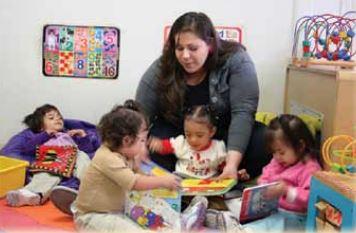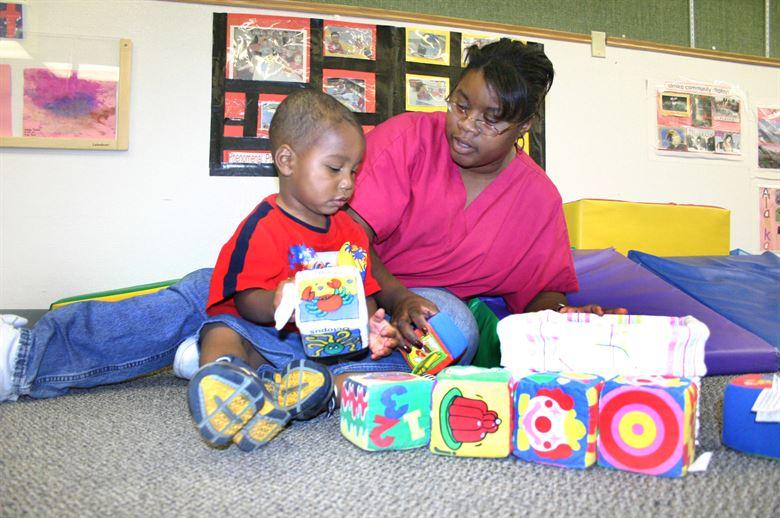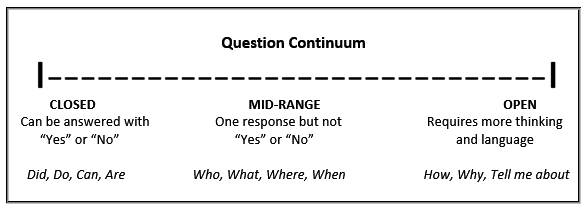|

Figure \(\PageIndex{1}\): Teachers will interact with groups of children [75]
|

Figure \(\PageIndex{2}\): And teachers will interact with children one-on-one [76]
|
It cannot be repeated enough that human beings are social creatures that thrive on relationships. In order to maximize a child’s interests, willingness to take risks, try again when initial attempts have not gone as planned, and learn to their fullest, we must establish and maintain relationships with children that foster trust and encourage autonomy and initiative.
Interactions should be as much of what we plan for as the materials and experiences themselves. Built into every curriculum plan should be thoughts about how the teacher will:
- Create a sense of safety and trust
- Acknowledge children’s autonomy
- Foster a growth mindset
- Extend learning through open-ended statements and conversations
Reflect back on Chapter 3 - The Teacher’s Role and the importance of establishing and maintaining relationships to foster brain development. The concept of a “Neuro-Relational approach” will be present in the curriculum that we plan for young children.
Quality interactions will include:
- Valuing each child for who they are
- Finding something special and positive about each child
- Maintaining a positive attitude
- Finding time each day to interact and make a connection with every child
- Respecting children’s opinions and ideas
- Being present for children
- Reflecting back what they say and do
- Listening to listen hear rather than respond
- Creating a warm and welcoming environment
- Being consistent as a means of establishing trust
- Focusing on the process
- Focusing on what children CAN do rather than what they can’t do YET
- Including families as valuable team members (for more information refer to Chapter 8 – Relating to Families)
- Understanding and respecting each child’s individual and group culture
|

|
Pause to Reflect
Do these make sense to you? Are there others? Which will be easiest for you? Most difficult? Why?
|
Communication goes hand in hand with interaction. Being aware of what we are saying and how we are saying it is crucial in establishing and maintaining relationships. Positive communication includes:
Nonverbal:
- Get down to children’s level
- Observe
- Be present
- Listen
- Understand
- Use positive facial expressions
- Look interested
- Smile
Verbal:
- Be aware of the tone and volume of your voice
- Speak slowly and clearly
- Use facial expressions and body movements that match your words
- Give choices and share control
- Focus on the positive
- Describe what you are doing as children are watching
- Model appropriate language
- Reflect back what children are saying
- Have conversations with multiple exchanges
- Consider close vs. open-ended questions and statements
The type of questions you ask will elicit different responses. Sometimes we want a direct answer while most of the time we want to generate deeper thinking to promote learning. Consider each of the questions below regarding the color blue:
- “Are you wearing blue today”?
- “What color are your pants”?
- “Tell me all the things you see that are blue”
Each will point out that the child’s pants are blue, but in very different ways.

Figure \(\PageIndex{3}\): The question continuum [77]
Considering what type of thinking we want to promote enables us to create questions and statements that spark that knowledge. Thinking is often broken down into two types:
- Convergent thinking – emphasizes coming up with one correct response; “converging” on the “right” answer.
- Divergent thinking – emphasized generating multiple responses, brainstorming and “thinking outside the box”; “diverging” into different ways of thinking and answering.
Both can be valuable as children develop and learn. Often starting with divergent questions and then following up with convergent questions allows for broad thinking that can then be narrowed down.
|

|
Pause to Reflect
How might you use these communication strategies in your planning, implementing, and reviewing/assessing curriculum for children?
|
|

|
Vignette
Teacher Odom sets up a play dough table with ingredients to make dough and materials to use after it is made. He lets the children know that he will be there if anyone wants to join him. Three children hurry over and he greets each of them and says, “I’m so happy you decided to join. Let’s get started”. He shows them the recipe and encourages them to decide how to proceed. They take turns adding the ingredients and he shows patience and interest as they take the lead, asking open-ended questions along the way, “What will we do next?” “What do you think will happen?” and facilitating conversations. He points out each of their contributions along the way and focuses on the processes they are using rather than the finished product. He encourages them to interact with each other, “Wow, look at how B did that” and “Isn’t it interesting how you both added flour but you did it so differently”. Other children come to join and he encourages the original three to find ways to include them. When the dough is complete, the children use a variety of rolling pins, cookie cutters, and dull plastic knives to play with it. He continues expressing his interest, by commenting on how each child is using the materials and asks open-ended questions to foster deeper learning.
|
|

|
Pause to Reflect
What are some ways the teacher fostered interactions with children to enhance their trust, encourage their autonomy and initiative, and foster thinking and learning?
|
|

|
Pause to Reflect
Going back to Table 6.1 on Development and Learning, can you find skills from each of the categories that the children would be enhancing? How do interactions help foster these skills?
|
In Chapter 4 (Observation and Assessment) we discussed the importance of using our observational skills to get to know the individual children we are planning for. We introduced the Cycle of Reflection, which begins with observing, documenting, and interpreting so that you can plan, implement and evaluate appropriate interactions and experiences that make sense and meet the needs of the particular children we are working with. Below we will take a deeper look at the ways we use our observational data and interpretations.










